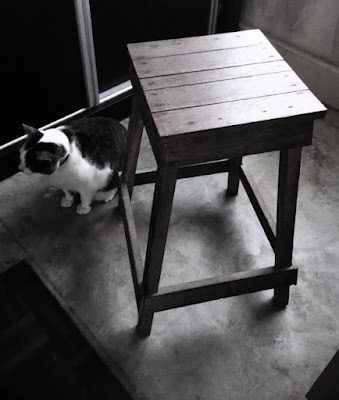When Budgie our cat got too old to jump from our bedroom window sill to the floor, we made a stool for him and put it next to the window. Budgie took one look at the stool and figured out our plan for him. He could then jump from the sill to the stool and then from the stool to the floor, usually with a soft grunt. The same process was repeated in reverse when he wanted to go out the window. We could have used one we already had in the house, or bought a new one which is nicer that the one we made. But the act of making the stool ourselves gave it special meaning; it was made to address a specific situation for a particular end-user. And it was made with love.
I recall this story because students continue to ask why their universities continue to focus so much on manual drawing and modelling, when much of the work produced in practice are digital? I would like to remind them about the emotional quality of drawing and making things by hand - each line on paper, each smudge carries with it the DNA of its creator. Over time, it develops its own identity - it is like a signature; unique and often hard to replicate.
This is why in the earlier years of architecture school, students are asked to make cardboard models, and prototypes and scale models of their furniture designs. Schools understand the value in the fabrication of these physical entities; they have presence, they can sit on a table in the studio to encourage a passing comment. They also have gravity; like the physical building or structure they represent in real life. These features are less possible with a digital model or rendering.
It is easier to have a design discussion with colleagues, lecturers and students using pencil on paper - it is more spontaneous than booting up the laptop. (I used to tease my juniors in the office that the hand has a closer connection to the brain compared to the laptop’s mouse. I tease but I mean it.) I am not against digital drawing and modelling, I make use of software to model, test and edit. It is so much easier to edit using digital software. But to start a project, start by drawing on paper, a large piece of paper with a fat marker or pencil and let the mind (and the hand) wander.
To reinforce my point, when we use our hands to carry out mundane tasks, the act can take on special meaning - eating is given an extra sensory experience, washing a child’s hair or wiping away a tear conveys care and affection, making bread or pots from clay leaves the trace of the hand that made them.
Revisit hand drawings years later and you are often still able to chart the course of their creation; the deeper imprint where the pen hesitated, the rubbed out lines when you changed your mind. And if you wanted to, you could continue the drawing - but only you.
 |
| I read this article by Christopher Alexander while in uni; perhaps it guided me into making a stool for Budgie |

No comments:
Post a Comment